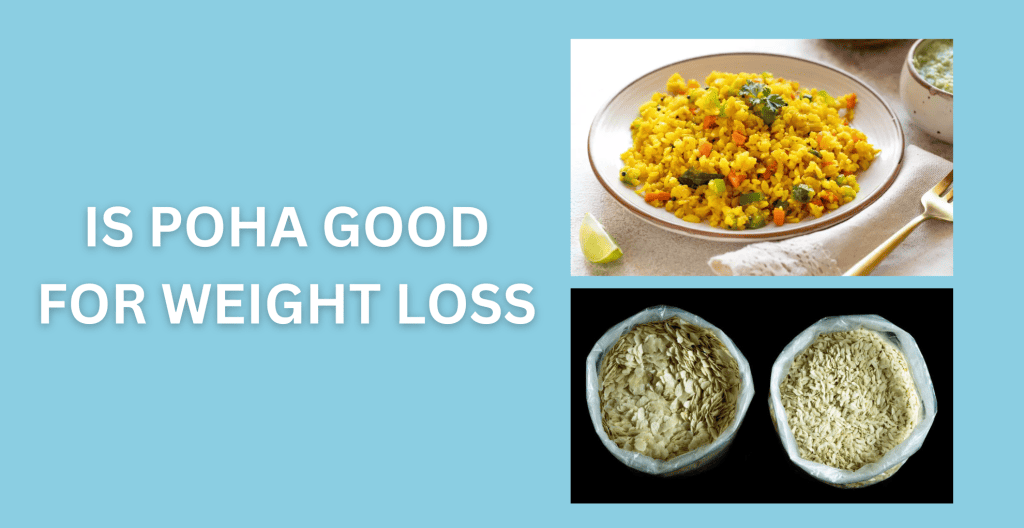Poha, the beloved flattened rice dish, often finds itself at the centre of a question that sparks curiosity: Is Poha good for weight loss? It is a staple breakfast dish in many Indian households. Regarding weight loss, incorporating poha into your diet can be advantageous due to its low calorie and fat content. Poha can aid in weight loss by providing a filling yet low-calorie meal option, promoting satiety, and helping to control overall calorie intake. However, excessive consumption or preparation methods involving high amounts of oil and added sugars can counteract its weight loss benefits, leading to potential weight gain instead. In this blog, we’ll dissect the benefits of poha, explore the answer to the question ‘Is Poha good for weight loss?’ different types and their unique properties, and provide valuable tips on incorporating them into your weight management plan.
Is Poha Good for You During Weight Loss?
Yes, poha can be a good option during weight loss due to its relatively low calorie and fat content and moderate protein and fibre content. Additionally, poha is a source of complex carbohydrates, which can provide sustained energy and keep you full for extended periods, potentially reducing overall calorie intake. However, paying attention to portion sizes and the preparation method is essential to avoid excessive oil or added sugars, which can contribute to weight gain. Several expert-recommended weight loss tips suggest that incorporating poha into a balanced diet that includes a variety of nutritious foods can support weight loss goals effectively.
Here are a few noteworthy points out of those tips justifying the answer to the question ‘Is poha good for weight loss?’
- Plain Poha: This can be a good source of carbohydrates and be part of a weight loss diet when prepared in moderation.
- Loaded Poha: High-calorie and high-fat versions are not ideal for weight loss.
- Portion Size: Crucial for controlling calorie intake, regardless of the preparation style.
- Overall Diet: Poha should be part of a balanced and calorie-controlled diet for effective weight management.
How to Eat Poha for Weight Loss?
To eat poha for weight loss, consider portion control and healthy cooking methods. Add vegetables and lean protein to your poha dish for a balanced meal. Avoid adding excessive oil or sugar, and pair it with a side of yoghurt or a protein-rich food to enhance satiety and support your weight loss goals. This dish may also help you achieve targets like how to lose 10 kgs in 10 days! Now let us read how you can eat poha during weight loss, which poha is good for weight loss and understand the answer to the question ‘Is Poha good for weight loss?’ in detail:
- Classic Poha (Kanda Poha): This dish features flattened rice (poha) cooked with mustard seeds, curry leaves, onions, and green chillies. It’s seasoned with turmeric powder, salt, and a squeeze of lemon juice for a tangy flavour. Garnished with fresh coriander leaves and grated coconut, it’s a flavorful and comforting breakfast or snack option.
- Vegetable Poha: Vegetable poha adds diced carrots, peas, bell peppers, and tomatoes to the classic poha base. These vegetables add colour, texture, and nutrition to the dish. Roasted peanuts or cashews can be sprinkled on top to provide a crunchy element and extra protein.
- Poha Upma: Poha upma is similar to the classic version but with a twist. It involves tempering mustard seeds, urad dal, chana dal, and curry leaves in oil before adding chopped onions and green chillies. The soaked poha is then mixed and seasoned with turmeric powder, salt, and sometimes a pinch of sugar. It’s garnished with fresh coriander leaves and grated coconut for added flavour.
- Sweet Poha (Kanda Pohe with Jaggery): Sweet poha is made by melting grated jaggery in ghee and mixing it with soaked poha. This creates a sweet and indulgent dish often flavoured with cardamom powder and garnished with grated coconuts and chopped nuts such as almonds or cashews. It’s enjoyed as a dessert or a special breakfast treat.
- Pair with yoghurt or protein: Enjoy poha with plain yoghurt or a protein-rich food like lentils or chickpeas to balance your meal and promote satiety. Adding peanuts to the poha is also a great option to enhance this dish’s taste!
- Poha Chivda: Poha Chivda, also called Chivda, is a popular Indian snack mix made with flattened rice (poha), spices, and other ingredients. It’s a flavorful and versatile dish enjoyed throughout the year as a tea-time snack, party appetiser, or light meal.
The types of poha mentioned above offer various options to explore which poha is good for weight loss, taking into account regional availability and individual dietary preferences. Whether you opt for the light and versatile white poha, the nutty and fibre-rich brown poha, or the denser and hearty red poha, each type provides unique nutritional benefits that can complement your weight loss journey!
How much Poha can we have daily for Weight Loss?
If you’re wondering, ‘Is Poha good for weight loss?’ it is also essential to consider how many times you consume it. Determining the specific amount of Poha suitable for weight loss is tricky as it depends on several factors, like your calorie needs, overall diet, and how you prepare it. While plain Poha can be a decent source of carbohydrates and relatively low in calories, remember that portion control is critical. You can add this dish into a 7 days diet plan for weight loss, and aim for a moderate serving, typically around 100-150 grams, and ensure it fits your daily calorie budget. A serving size of poha is around 1/2 to 1 cup cooked, depending on individual calorie needs and dietary goals.
Pairing poha with other nutrient-rich foods like vegetables, lean proteins, and healthy fats is essential to create a well-rounded meal that promotes satiety and provides necessary nutrients. Additionally, consider your cooking method and ingredients; opt for healthier preparations such as steaming or sautéing with minimal oil and adding plenty of vegetables for fibre and volume.
Which Poha is Best for Weight Loss?
While the type of Poha doesn’t drastically impact weight loss, how it’s prepared makes a significant difference. For weight management, plain brown rice Poha is the most suitable option. For a better approach, you may explore and buy weight loss plans, where a nutritionist will guide you on cooking methods and help you choose and understand which poha is best for weight loss under your budget and more!
Let us look at the types of flattened rice/poha to understand better which Poha is best for weight loss:
- White Poha: White poha, also known as “thin” or “nylon” poha, is the most commonly used variety. It is made from white rice, where the rice grains are flattened and dried to create thin, translucent flakes. White poha has a light texture and mild flavour, making it versatile for various recipes. It is often used in dishes like kanda poha (flavoured with onions) or as a base for sweet treats like poha ladoo.
- Brown Poha: Brown poha, also called “red rice” poha, is made from brown rice grains. Unlike white poha, which undergoes a refining process that removes the outer bran layer, brown poha retains this bran layer, giving it a higher fibre content and a nuttier flavour. Brown poha is slightly thicker and chewier compared to white poha. It is a healthier alternative as it contains more nutrients, including fibre, vitamins, and minerals.
- Red Poha: Red poha, also known as “red rice flakes,” is made from red rice grains. Similar to brown poha, red poha retains the outer bran layer of the rice, resulting in a higher fibre content and nutritional value than white poha. Red poha has a distinctive reddish-brown colour and a slightly denser texture than white poha. It offers a nutty flavour and is often used in dishes where a firmer texture is desired, such as upma or bhel puri.
- Jada Poha: This type of poha is similar to white poha but is thicker in texture and takes a little longer to cook. Thick poha retains its shape better when cooked and is often used in recipes where a firmer texture is desired, such as in dishes like batata poha (poha cooked with potatoes) or as a base for snacks like chivda. Thick poha offers a hearty bite and is a popular choice in some areas of India for its versatility and satisfying texture.
Brown rice Poha offers more fibre and essential nutrients than white rice Poha, contributing to satiety and potentially reducing cravings throughout the day. Preparing it with minimal oil, spices, and minimal to moderate amounts of vegetables like onions and tomatoes helps keep the calorie count in check. Remember, moderation remains critical, regardless of the Poha type. Hence, the answer to the question ‘Which Poha is best for weight loss?’ is brown rice poha!
Benefits of Eating Poha for Weight Loss
With Poha, a staple in many Indian households, the question arises: Is Poha good for weight loss? For those who are on a weight loss journey. Incorporating poha, or flattened rice, into your diet can offer several advantages for those aiming to achieve weight loss goals, like ‘How to lose 15 kgs in a month?’ From its low-calorie to high-fibre content and customisable preparation options, poha is a valuable addition to a weight loss regimen. Let’s explore how poha can support your journey towards a healthier and leaner you:
- Low in Calories: Poha is relatively low in calories, making it a suitable option for those aiming to lose weight. A typical serving of poha (around 1/2 to 1 cup cooked) contains approximately 70-100 calories, depending on ingredients and portion size. Consuming foods with lower calorie density can help create a calorie deficit, which is essential for weight loss.
- High in Fibre: Poha contains dietary fibre, which can aid in weight loss by promoting feelings of fullness and reducing hunger. Fibre-rich foods help slow digestion, keeping you satisfied for extended periods and reducing the likelihood of overeating. Additionally, fibre supports digestive health and may help regulate blood sugar levels, further supporting weight management efforts.
- Nutrient Density: While poha is low in calories, it still provides essential nutrients such as carbohydrates, vitamins, and minerals. Opting for whole grain poha varieties ensures you get more nutrients and fibre than refined versions. These nutrients are essential for overall health and can contribute to a well-balanced diet conducive to weight loss.
- Versatility: Poha is a versatile ingredient that can be easily incorporated into various meals and recipes. It can be enjoyed as a breakfast dish, snack, or light dinner option. Adding nutrient-rich toppings such as vegetables, lean proteins, and healthy fats can create satisfying and nutritious meals that support your weight loss goals.
- Quick and Convenient: Poha is quick and easy to prepare, making it a convenient option for busy individuals seeking healthy meals. With minimal cooking time required, poha can be a go-to option for those looking to make nutritious meals without spending much time in the kitchen.
- Customisable: Poha can suit individual tastes and dietary preferences. Whether you prefer savoury or sweet flavours, numerous recipes and variations exist. You can tailor poha to fit your weight loss plan by incorporating wholesome ingredients and controlling portion sizes while enjoying delicious and satisfying meals.
Best Recipes of Poha for Weight Loss
We’ll explore a range of nutritious, satisfying options bursting with flavour. From incorporating protein-rich ingredients to adding various vegetables and managing spice levels, here are recipes to prepare healthy, delectable flattened rice/poha alternatives. Feel free to experiment with any of these recipes to find the one that best suits your taste buds and understand better which poha is good for weight loss and working efficiently for you! Here are three recipe suggestions
- Basic/Classic Poha
- Vegetable Poha
- Soya Poha
Let us look at each of these-
Basic Poha
Basic poha is a traditional Indian breakfast dish made from flattened rice (poha) seasoned with spices and tempered with mustard seeds, curry leaves, and green chillies. It’s light, flavorful, quick, and easy to prepare.
| Serving Size | Time Required | Difficulty Level |
| 2-3 servings | 20 minutes | Easy |
Ingredients:
- 2 cups poha (flattened rice)
- 1 medium-sized onion, finely chopped
- 1 medium-sized potato, boiled and diced
- 1 green chilli, chopped
- 1/2 teaspoon mustard seeds
- 1/2 teaspoon turmeric powder
- 1/4 cup roasted peanuts
- Few curry leaves
- 2 tablespoons oil
- Salt to taste
- Fresh coriander leaves for garnish
- Lemon wedges for serving
Steps:
- Rinse the poha under running water in a colander or sieve. Allow it to soften for about 5 minutes, then gently fluff it with a fork to separate the grains.
- Heat oil in a pan or kadhai over medium heat. Add mustard seeds and let them splutter.
- Add chopped onions, green chillies, and curry leaves. Sauté until the onions turn translucent. Then add boiled diced potatoes to the pan and cook for a few minutes until lightly browned.
- Lower the heat and add turmeric powder and salt. Mix well.
- Add the rinsed and fluffed poha to the pan. Gently toss everything together until the poha is well coated with the spices and heated.
- Add roasted peanuts and mix well.
- Garnish with fresh coriander leaves and serve hot with lemon wedges on the side.
Vegetable Poha
Vegetable poha is an enhanced version of basic poha, incorporating a variety of colourful vegetables for added nutrition and flavour. It’s a wholesome and satisfying breakfast or snack option for those with ambitious goals like how to lose 5 kgs in a week!
| Serving Size | Time Required | Difficulty Level |
| 3-4 servings | 25 minutes | Easy |
Ingredients:
- 2 cups poha (flattened rice)
- 1 medium-sized onion, finely chopped
- 1 small carrot, diced
- 1/2 cup green peas
- 1/2 cup finely chopped bell peppers (red, green, and yellow)
- 1 green chilli, chopped
- 1/2 teaspoon mustard seeds
- 1/2 teaspoon turmeric powder
- 1/4 cup roasted peanuts
- Few curries leave
- 2 tablespoons oil
- Salt to taste
- Fresh coriander leaves for garnish
- Lemon wedges for serving
Steps:
- Rinse and fluff the poha as described in the basic poha recipe above.
- Heat oil in a pan or kadhai over medium heat. Add mustard seeds and let them splutter.
- Add chopped onions, green chillies, and curry leaves. Sauté until the onions turn translucent.
- Add diced carrots, green peas, and bell peppers to the pan. Cook for a few minutes until the vegetables are slightly tender.
- Lower the heat and add turmeric powder and salt. Mix well.
- Add the rinsed and fluffed poha to the pan. Gently toss everything together until the poha is well coated with the spices and heated.
- Add roasted peanuts and mix well.
- Garnish with fresh coriander leaves and serve hot with lemon wedges on the side.
Soya Poha
Soya poha is a protein-rich variation of poha, where soaked and boiled soya granules are added to the traditional poha recipe. It’s a nutritious and filling dish ideal for those looking to incorporate more protein into their diet.
| Serving Size | Time Required | Difficulty Level |
| 3-4 servings | 30 minutes | Easy |
Ingredients:
- 2 cups poha (flattened rice)
- 1 cup soya granules (textured vegetable protein)
- 1 medium-sized onion, finely chopped
- 1 small tomato, finely chopped
- 1 green chilli, chopped
- 1/2 teaspoon mustard seeds
- 1/2 teaspoon turmeric powder
- 1/4 cup roasted peanuts
- Few curry leaves
- 2 tablespoons oil
- Salt to taste
- Fresh coriander leaves for garnish
- Lemon wedges for serving
Steps:
- Rinse and fluff the poha as described in the basic poha recipe above.
- Soak the soya granules in hot water for 15-20 minutes. Drain and squeeze out excess water.
- Heat oil in a pan or kadhai over medium heat. Add mustard seeds and let them splutter.
- Add chopped onions, green chillies, and curry leaves. Sauté until the onions turn translucent.
- Add chopped tomatoes to the pan and cook until soft and mushy.
- Add soaked and squeezed soya granules to the pan. Cook for a few minutes until they are heated through.
- Lower the heat and add turmeric powder and salt. Mix well.
- Add the rinsed and fluffed poha to the pan. Gently toss everything together until the poha is well coated with the spices and heated.
- Add roasted peanuts and mix well.
- Garnish with fresh coriander leaves and serve hot with lemon wedges on the side.
These detailed recipes provide step-by-step instructions for preparing basic poha, vegetable poha, and soya poha, offering various delicious and nutritious options to enjoy this versatile Indian dish.
Pairing Poha with Protein Rich Foods for Weight Loss
While Poha offers potential weight management benefits due to its fibre content and low-fat nature, incorporating protein-rich foods can significantly enhance its effectiveness. Protein promotes satiety, helping you feel fuller for longer and reducing the urge to snack. It also supports muscle preservation, which plays a crucial role in maintaining a healthy metabolism.
By pairing Poha with protein sources like eggs, low-fat yoghurt, lean meats, legumes, or tofu, you create a balanced and satisfying meal that fuels your body while keeping you on track with your weight loss goals. This approach encourages sustained energy levels, curbs cravings, and promotes a healthy weight management journey.
Protein takes longer to digest than carbohydrates, helping you feel fuller for longer periods and reducing the likelihood of overeating. Additionally, protein is essential for muscle repair and growth, which is vital for maintaining a healthy metabolism and supporting weight loss. By pairing poha with protein-rich foods, you can create balanced and nutritious meals that satisfy your hunger and contribute to your weight loss goals, such as how to lose 3 kgs in a week!
Nutritional Value of Poha
Poha, or flattened rice, is a popular Indian breakfast dish known for its light and fluffy texture. It is a good source of carbohydrates and provides essential nutrients such as iron, vitamins, and minerals. Here’s a breakdown of its nutritional value:
| Nutrient | Amount |
| Calories | 350 |
| Carbohydrates | 65g |
| Protein | 10g |
| Fat | 1g |
| Fibre | 2g |
| Iron | 5mg |
Expert Review on Is Poha Good for Weight Loss
While many wonder, “Is rice good for weight loss?” it’s worth noting that poha, a variation of flattened rice, can be a beneficial addition to a weight loss diet due to its lower calorie content and high fibre content, helping to keep you feeling full and satisfied for more extended periods. Poha, the famous Indian flattened rice dish, can be a friend in your weight loss journey. Its low calorie and fat content and moderate protein and fibre can help you feel full for longer and potentially reduce overall calorie intake. However, watch out for portion sizes and preparation methods. Opt for steaming, minimal oil, and vegetables for more fibre. Pair it with protein-rich foods like eggs or yoghurt for added satiety.
Remember, balance is key. Incorporate poha into a calorie-controlled, diverse diet for optimal weight management. To sum up the answer to the question ‘Is poha good for weight loss?’ here’s what the expert recommends:
- Choose brown poha: It offers a higher fibre content than white poha, further promoting satiety and gut health.
- Control portion sizes: Aim for moderate servings, typically around 100-150 grams cooked.
- Choose healthy cooking methods: Steam, saute with minimal oil or use healthy fats like olive oil.
- Boost protein and fibre: Add vegetables, legumes, lentils, or low-fat yoghurt for increased satiety and a well-balanced meal.
Experts agree that poha can be a weight-loss-friendly option when prepared and consumed thoughtfully. However, focusing on a balanced and calorie-controlled diet is crucial rather than relying solely on poha for weight management.
References
“(PDF) Studies on Development of High Protein Instant Poha (Beaten Rice) – A Traditional Indian Breakfast.” 2020. ResearchGate. https://www.researchgate.net/publication/340062357_Studies_on_Development_of_High_Protein_Instant_Poha_Beaten_Rice_-_A_Traditional_Indian_Breakfast
“Effect on physical, chemical and functional characteristics during transformation of paddy to flaked rice: (POHA).” 2019. International Journal of Chemical Studies. https://www.chemijournal.com/archives/2019/vol7issue3/PartB/7-1-500-441.pdf
“International Journal of Nursing Education and Research.” n.d. International Journal of Nursing Education and Research. Accessed February 25, 2024. https://ijneronline.com/AbstractView.aspx?PID=2022-10-3-18
FAQs
Can I lose weight eating Poha?
Yes, you can lose weight eating poha. Poha, or flattened rice, is a popular Indian breakfast dish known for its low calorie and fat content. It would be best to explore which poha is good for weight loss and working for you by trying different types and recipes of poha. With approximately 70-350 calories per serving, poha provides a light and satisfying option for those aiming to shed pounds. Incorporating nutrient-rich toppings like vegetables and lean proteins can further enhance its weight loss benefits!
Is it OK to eat poha every day during weight loss?
Yes, eating poha daily during weight loss is generally okay, provided it’s consumed in moderation. Poha offers a versatile and convenient option for breakfast or snacks, making it easy to incorporate into daily meals. However, it’s crucial to be mindful of portion sizes and avoid excessive oil or high-calorie toppings that can sabotage weight loss efforts.
Is it OK to eat poha while dieting?
Yes, eating poha while dieting is perfectly fine, as long as it’s prepared healthily. Poha is naturally low in calories and fat, making it suitable for individuals looking to manage their weight. However, finding out which poha is good for weight loss and portion sizes and avoiding unhealthy cooking methods like deep-frying or excessive oil usage is essential. Incorporating nutrient-rich toppings such as vegetables, nuts, seeds, and lean proteins can further enhance the nutritional value of poha and support overall health and well-being during dieting.
Is poha better than oats?
Both poha and oats have their nutritional benefits, and the choice between them depends on individual preferences and dietary needs. Poha, being lighter and easier to digest, can be a preferable option for those with sensitive stomachs or those looking for a quick and convenient breakfast. On the other hand, oats are higher in fibre and protein, providing longer-lasting satiety and potentially aiding in weight loss. Ultimately, the best choice between poha and oats depends on taste, texture, and overall dietary preferences.
Is poha a junk food?
No, poha is not considered junk food. It is a traditional Indian dish made from flattened rice and is commonly consumed as a breakfast or snack option. Poha can be part of a healthy and balanced diet when prepared with nutritious ingredients and consumed in moderation.
Is eating poha better than rice?
Poha and rice have nutritional benefits, and their choice depends on individual dietary preferences and health goals. Poha, being lighter and lower in calories, can be a preferable option for those watching their calorie intake or looking for a quick and easy meal option.
Is poha good for belly fat?
Poha can be part of a balanced diet to reduce belly fat combined with regular exercise and healthy eating habits. Its low calorie and fat content and moderate fibre and protein can contribute to weight loss, including reducing belly fat. Additionally, nutrient-rich toppings like vegetables, lean proteins, and healthy fats can enhance its belly-fat-burning properties.









